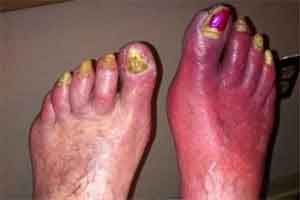New peripheral artery disease guidelines emphasize medical therapy and structured exercise

New guidelines for the treatment of peripheral artery disease (PAD), include recommendations on the use of antiplatelet therapy to reduce the risk of blood clots and statin drugs to lower cholesterol and advise PAD patients to participate in a structured exercise program.
 Association/American College of Cardiology guidelines are published in the American Heart Association journal Circulation and the Journal of the American College of Cardiology.
Association/American College of Cardiology guidelines are published in the American Heart Association journal Circulation and the Journal of the American College of Cardiology.
Nearly 9 million Americans have PAD, a condition characterized by leg arteries that are narrowed and clogged by atherosclerosis, the same disease process that underlies heart attacks and stroke. Because the arteries are narrowed by plaque buildup, they cannot supply enough blood to the legs and people with PAD experience pain and difficulty walking. Left untreated, PAD can lead to disability and even leg amputations.
The new recommendations replace guidelines last updated in 2011. “Peripheral artery disease is a common disease with devastating consequences, and clinical practice guidelines are an important tool to improve the quality of care for patients with this disease,” said Heather Gornik, M.D., vice chair of the PAD writing committee and cardiologist and vascular medicine specialist at the Cleveland Clinic.
When a patient has PAD, the goal of treatment is to prevent cardiovascular events such as heart attack and stroke and to improve walking ability and function. In some cases, vascular procedures to restore blood flow to the affected leg—such as angioplasty and stent placement using artery bypass surgery—are recommended. During angioplasty, special tubing with an attached deflated balloon is threaded through the leg arteries. The balloon is inflated to widen blocked areas where blood flow to the leg muscle has been reduced or cut off. Angioplasty is often combined with placement of a stent to help prop the artery open and decrease the chance of another blockage.
These vascular procedures are frequently used to potentially prevent amputation for patients with the most severe forms of PAD, including those with pain in the leg at rest due to a lack of blood flow and patients with a non-healing wound.
The new guidelines also included recommendations for when these vascular procedures should be considered for an additional group of patients who have less severe PAD but who continue to have significant limitations in walking despite treatment with medications and a structured exercise program. For these patients, vascular procedures to improve blood flow to the legs continue to be a reasonable treatment option according to the guidelines.
Regardless of whether vascular procedures are needed, all patients with PAD are at risk for developing blood clots in the legs and having a heart attack or stroke. Medical management recommendations continue to include the use of statin drugs, which reduce cholesterol in the blood, thereby making it less likely to accumulate within the walls of the arteries. The recommendations continue to advise healthcare providers to prescribe antiplatelet therapy such as aspirin or clopidogrel for patients with PAD, and the guidelines discuss situations where dual anti-platelet therapy, the combination of aspirin and clopidogrel, may be considered, such as after vascular surgery or stenting procedures.
As in earlier guidelines, physical activity is a cornerstone of managing PAD, and a new recommendation is for all patients with PAD to participate in a structured exercise program. Structured exercise should be individualized to the patient and should include specific instructions for the type, frequency, intensity and duration of exercise. The most effective form of structured exercise, according to the guidelines, is a supervised exercise program in a hospital or outpatient exercise facility, but other options include home- or community-based walking exercise or alternative forms of exercise such as upper-body exercises.
Previous guidelines emphasized the importance of smoking cessation for the patient with PAD, but the new guidelines go further–patients with PAD are now strongly advised to avoid second-hand smoke.
Another new recommendation for PAD patients is to get an annual flu shot to avoid cardiovascular complications of flu, such as heart attacks, because patients with PAD often have narrowed coronary arteries, a risk factor for heart attack.
Measuring ankle brachial index (ABI) by healthcare providers continues to be recommended for patients with symptoms and signs of PAD. The ankle-brachial index compares the blood pressure in the legs to the blood pressure in the arms to determine if there is significant narrowing of the arteries due to PAD. For patients without symptoms of PAD, but who are at increased risk, it is reasonable for healthcare providers to use the ABI to determine if PAD is present.
According to the guidelines, people at increased risk for PAD are those 65 and older, as well as people between 50 and 64 who smoke or have high cholesterol, high blood pressure, diabetes, or a family history of PAD. Others deemed at increased risk include people younger than 50 with diabetes plus one more additional factor, such as high cholesterol or high blood pressure. People with a history of atherosclerosis in another part of the body — such as the coronary arteries (blood vessels to the heart), the carotid arteries (the main blood-ferrying vessel from the heart to the brain) or in the blood vessels of the abdomen or kidneys — are also at increased risk.
“Periodically reassessing how we manage and treat complex diseases by incorporating the latest evidence is critical to ensure that clinicians are equipped to provide optimal care for their patients,” said Marie Gerhard-Herman, M.D., chair of the writing group and a cardiologist at Brigham and Women’s Hospital.

